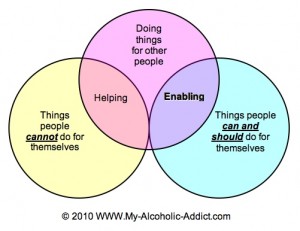Although enabling behavior is most often associated with the loved ones of addicts and alcoholics, and victims of domestic violence, it can become an issue with any kind of dysfunctional personality.
Why am I so certain of this? Because enabling behavior is something that I struggle with.
The danger of enabling behavior is something that the enabler may have to learn over and over again, because it is in our nature to want to help. Enabling, in and of itself, is actually a positive thing. Dictionary.com lists the following definitions: 1. to make able; give power, means, competence, or ability to; authorize 2. to make possible or easy 3. to make ready; equip (often used in combination)
 Enabling behavior is fueled by our feelings of love and friendship. It’s only natural to want to help someone we care about, but when it comes to certain life and growth issues or repetitive, negative dysfunctional behaviors, our help simply allows the problem to persist. In other words we are doing more harm than good by allowing that person to avoid making the changes they need to make. At the same time, it is difficult to stop our enabling behavior lest we seem cold, calloused and uncaring.
Enabling behavior is fueled by our feelings of love and friendship. It’s only natural to want to help someone we care about, but when it comes to certain life and growth issues or repetitive, negative dysfunctional behaviors, our help simply allows the problem to persist. In other words we are doing more harm than good by allowing that person to avoid making the changes they need to make. At the same time, it is difficult to stop our enabling behavior lest we seem cold, calloused and uncaring.
So how can one work through these gray areas of love to stop the enabling behavior?
Pay close attention to what you are doing and what the other person is doing. If, for instance, a grown child comes back home to live after being away, that is the help that is natural for parents to offer. Falling back into the old mommy or daddy role however, will not help them get out on their own. There are now more meals to prepare, more clothes to wash, and more house cleaning to be done. If you don’t expect them to carry their share of the load, they won’t. If you feel as if you are being taken advantage of, you are!
Your feelings of resentment are a direct result of your enabling behavior. You would actually show them more love by raising your level of expectation. That will encourage them to develop the habit of sharing responsibility with another human being and prepare them for a healthier marital relationship some day. If you are doing it all for them, how will they grow? My experience has taught me that when any relationship begins to feel like too much work, you are likely to be enabling.
There are a variety of signs that indicate destructive enabling behavior. I use the word destructive because when these signs are present, the most genuine love you can offer is to correct yourself and stop your enabling behavior. So ask yourself these questions:
- Am I accepting excuses, rationalizations, and
 justifications that I would not accept from other people?
justifications that I would not accept from other people? - Am I trying to, or do I think I can fix them?
- Am I doing for them things they should be doing for themselves?
- Is it my help that is overcoming what would be the natural consequences of their action or inaction?
- Am I repeatedly rescuing them from situations that were avoidable or that happen over and over?
- Am I avoiding confronting the problems the situation causes me, just to keep the peace between us?
When we allow our enabling behavior to go unchecked we invite disaster. The drain on our energy becomes intolerable and only way out is to resort to the kind of tough love generally thought of in the case of drug and alcohol abuse interventions. The receiver of this tough love generally sees it as betrayal and will transfer the blame to you. Armed with you as the bad guy they will either seek another enabler or find their own strength. Time may heal the wounds or not… that must be left in the Father’s hands. Those of us that are prone to enabling behavior set ourselves up time and again to go through this emotional roller coaster as we try to work our way through these gray areas of love.
Lord help me to encourage others to depend on You, and to walk in Your strength in all aspects of their lives. Help me to wisely discern the fine line between helping others to grow strong, and enabling them to be dependent upon anything less than You. Help me to wisely navigate the gray areas of love in victory for Your glory! Amen.
Blessings & Adventure
Lynn “lynnibug” Rios
My desire is to help others, not hurt them. I take responsibility for my own actions, understanding that to accomplish this I must overcome my enabling behavior.


It’s a question of finding the line. Take #4 “Is it my help that is overcoming what would be the natural consequences of their action or inaction,” — my best friend from college died from alcoholism in January — you do what you can do, what you think you need to do, what you think has to be done — and I’d rather be guilty of taking action than sitting back and doing nothing.
Excellent post.
Thank you Dennis! I was once involved with a man who had a crack habit. In my heart I knew he was lying to me all the time about being clean, but I really wanted to believe he was turning around. My enabling caused me much difficulty, and only delayed him hitting bottom again. Sometimes nothing we can do is enough. It is a hard call.
Lynn,
This one hit home and hard! Thank you for writing it and more for sharing it! So true, so true….so true.
I am learning this lesson again in my life.
Keep up the great work!
Kris
Thank you for your kind words Kris